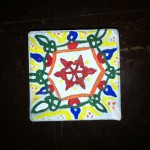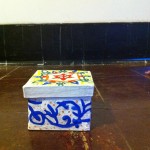Mediations on the Arabesque
Materials: acrylic paint on cardboard
In 1978, Edward Said published a watershed book titled Orientalism, where he criticized Western scholarship for taking a patronizing and overly simplified view of Islamic art and culture. He wrote that Orientalism contained the false assumption that art and culture throughout the Middle East and other Islamic areas is stagnant, homogenous, and when compared to Western art, is inherently inferior. He suggested that this approach had a more pernicious subtext than sheer paternalistic ignorance: it highlighted the merits of colonialism. Colonial rulers justified their civilizing mission, helping a trailing culture adopt a superior Western culture.
Later scholarship built on Said’s damning portrait of Orientalism, and exposed further pitfalls of Western interpretation. S. H. Nasr argues that viewing Islamic art strictly through a sociopolitical lens takes the soul and spirituality out of it (even though it was created specifically for that purpose). He argues that Islamic art is not designed for passive observation, like a painting in a museum, but rather, is a functional tool for remembering and practicing Islam. Further, many of the symbols and schemes associated with Islamic art are not temporal, repeated over hundreds of years in different times and places. Western scholarship mistakenly situates Islamic art solely in the visual world, neglecting its spiritual significance that transcends a single context. Gulru Necipoglu takes a less skeptical approach, arguing that geopolitical and historical context is critical for understanding Islamic art. Necipoglu argues that Islamic art must be understood in its own context. For example, many mosques were built by non-Muslim Armenians and Greek artisans who were not versed in the spiritual subtleties of their work. Ismail R. Al-Faruqi agrees with Necipoglu, though he argues that Western scholarship is too focused historical context. He concludes that artistic meaning is not static and can evolve over time.
In my piece, I comment on the Western interpretation of Islamic art, which has emphasized the arabesque. Western scholars have used the arabesque to suggest that Islamic art is inferior to Western art, because Muslims were incapable of realistic and detailed representations of the natural world. The simplistic renderings of leaves and flowers demonstrate that Muslims were incapable of complex and intricate design. (Al-Faruqi quoting E. Herzfeld, Misconceptions of the Nature of Islamic Art, p. 30).Such Western scholars have cast off the arabesque, geometric design, and calligraphy as mere “decoration” or “ornament.” They are not complete and autonomous artistic works that stand on their own. Necipoglu explains, “Generally classified in terms of its geometric, vegetal, and calligraphic variants, the so-called arabesque (occasionally intertwined with stylized figures and animals) was assigned a purely decorative function that differed fundamentally from the iconographic tradition of Western representational art. The arabesque’s alleged absence of meaning facilitated its appropriation by modern European architects and industrial designers” (Ornamentalism and Orientalism, p. 63).
My piece is a small box that likely would have been classified as “ornament” by Western scholars of the last generation. The pattern of leaves, flowers, and interlocking vines runs along the sides of the box in blue. The top features a multi-colored geometric pattern that also has a vine-like and leaf-like quality. The geometric form at the center is a loose rendition of a flower. There are specs of gold paint to emphasize that the box likely would have been made with precious metals.






